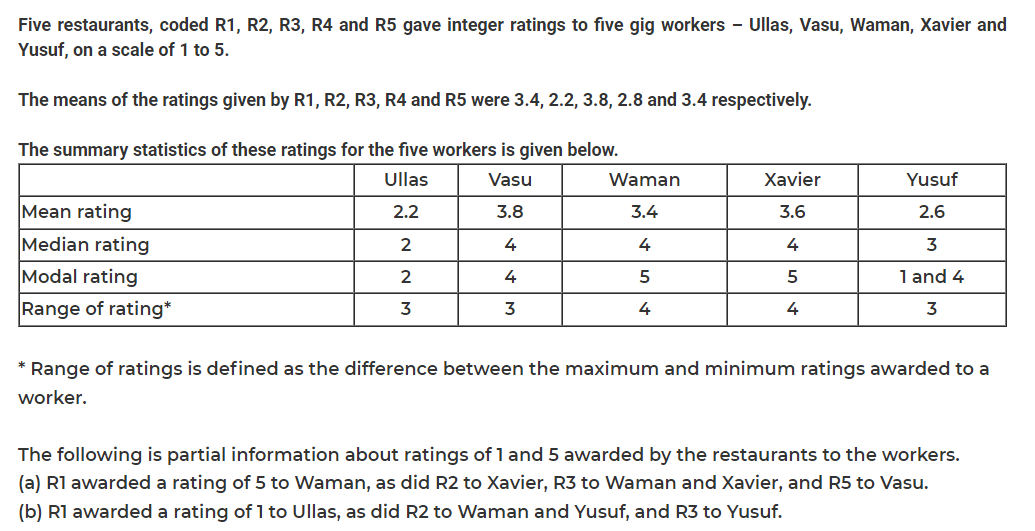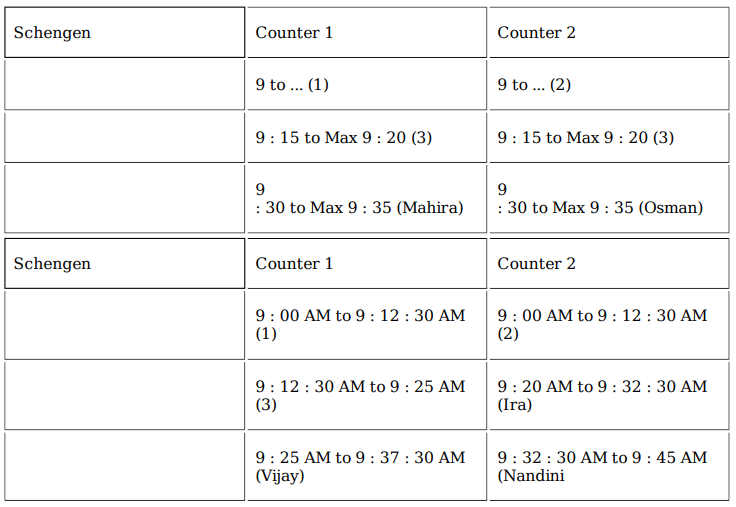Live Updates
• CATKing has launched new chat bot.

• New video on Logs has been released.
13.2K
Learners
asked the doubt

Previous Year Questions
Which among the following options best represents the number of domestic cosmetic products that had both the approvals?
Video Explanation

If 70 cosmetic products did not have EU approval, then how many nutrition products had both the approvals?
Video Explanation

If 50 nutrition products did not have EU approval, then how many domestic cosmetic products did not have EU approval?
Video Explanation

Every day a widget supplier supplies widgets from the warehouse (W) to four locations – Ahmednagar (A), Bikrampore (B), Chitrachak (C), and Deccan Park (D). The daily demand for widgets in each location is uncertain and independent of each other. Demands and corresponding probability values (in parenthesis) are given against each location (A, B, C, and D) in the figure below. For example, there is a 40% chance that the demand in Ahmednagar will be 50 units and a 60% chance that the demand will be 70 units. The lines in the figure connecting the locations and warehouse represent two-way roads connecting those places with the distances (in km) shown beside the line. The distances in both the directions along a road are equal. For example, the road from Ahmednagar to Bikrampore and the road from Bikrampore to Ahmednagar are both 6 km long.
Every day the supplier gets the information about the demand values of the four locations and creates the travel route that starts from the warehouse and ends at a location after visiting all the locations exactly once. While making the route plan, the supplier goes to the locations in decreasing order of demand. If there is a tie for the choice of the next location, the supplier will go to the location closest to the current location. Also, while creating the route, the supplier can either follow the direct path (if available) from one location to another or can take the path via the warehouse. If both paths are available (direct and via warehouse), the supplier will choose the path with minimum distance.
If the last location visited is Ahmednagar, then what is the total distance covered in the route (in km)?
Video Explanation

What is the chance that the total number of widgets delivered in a day is 260 units and the route ends at Bikrampore?
Video Explanation

If the first location visited from the warehouse is Ahmednagar, then what is the chance that the total distance covered in the route is 40 km?
Video Explanation

If Ahmednagar is not the first location to be visited in a route and the total route distance is 29 km, then which of the following is a possible number of widgets delivered on that day?
Video Explanation

If the last location visited is Ahmednagar, then what is the total distance covered in the route (in km)?
Video Explanation

What is the chance that the total number of widgets delivered in a day is 260 units and the route ends at Bikrampore?
Video Explanation

If the first location visited from the warehouse is Ahmednagar, then what is the chance that the total distance covered in the route is 40 km?
Video Explanation

If Ahmednagar is not the first location to be visited in a route and the total route distance is 29 km, then which of the following is a possible number of widgets delivered on that day?
Video Explanation

How many households did Lahur meet on the second day?
Video Explanation

How many households did Tohri meet on the first day?
Video Explanation

A few salesmen are employed to sell a product called TRICCEK among households in various housing complexes. On each day, a salesman is assigned to visit one housing complex. Once a salesman enters a housing complex, he can meet any number of households in the time available. However, if a household makes a complaint against the salesman, then he must leave the housing complex immediately and cannot meet any other household on that day. A household may buy any number of TRICCEK items or may not buy any item. The salesman needs to record the total number of TRICCEK items sold as well as the number of households met in each day. The success rate of a salesman for a day is defined as the ratio of the number of items sold to the number of households met on that day. Some details about the performances of three salesmen - Tohri, Hokli and Lahur, on two particular days are given below.
1. Over the two days, all three of them met the same total number of households, and each of them sold a total of 100 items.
2. On both days, Lahur met the same number of households and sold the same number of items.
3. Hokli could not sell any item on the second day because the first household he met on that day complained against him.
4. Tohri met 30 more households on the second day than on the first day.
5. Tohri's success rate was twice that of Lahur's on the first day, and it was 75% of Lahur's on the second day.
What was the total number of households met by Tohri, Hokli and Lahur on the first day?
Video Explanation

How many TRICCEK items were sold by Tohri on the first day?
Video Explanation

How many households did Lahur meet on the second day?
Video Explanation

How many households did Tohri meet on the first day?
Video Explanation

What was the total number of households met by Tohri, Hokli and Lahur on the first day?
Video Explanation

How many TRICCEK items were sold by Tohri on the first day?
Video Explanation

How many times does Team 4 pass through Station E in a day?
Video Explanation

A, B, C, D, E and F are the six police stations in an area, which are connected by streets as shown below. Four teams – Team 1, Team 2, Team 3 and Team 4 –
patrol these streets continuously between 09:00 hrs. and 12:00 hrs. each day.
The teams need 30 minutes to cross a street connecting one police station to another. All four teams start from Station A at 09:00 hrs. and must return to Station A by 12:00 hrs. They can also pass via Station A at any point on their journeys.
The following facts are known.
1. None of the streets has more than one team traveling along it in any direction at any point in time.
2. Teams 2 and 3 are the only ones in stations E and D respectively at 10:00 hrs.
3. Teams 1 and 3 are the only ones in station E at 10:30 hrs.
4. Teams 1 and 4 are the only ones in stations B and E respectively at 11:30 hrs.
5. Team 1 and Team 4 are the only teams that patrol the street connecting stations A and E.
6. Team 4 never passes through Stations B, D or F.
Which one among the following stations is visited the largest number of times?
Video Explanation

How many times do the teams pass through Station B in a day?
Video Explanation

Which team patrols the street connecting Stations D and E at 10:15 hrs?
Video Explanation

How many times does Team 4 pass through Station E in a day?
Video Explanation

Which one among the following stations is visited the largest number of times?
Video Explanation

How many times do the teams pass through Station B in a day?
Video Explanation

Which team patrols the street connecting Stations D and E at 10:15 hrs?
Video Explanation

An air conditioner (AC) company has four dealers – D1, D2, D3 and D4 in a city. It is evaluating sales performances of these dealers. The company sells two variants of ACs – Window and Split. Both these variants can be either Inverter type or Non-inverter type. It is known that of the total number of ACs sold in the city, 25% were of Window variant, while the rest were of Split variant. Among the Inverter ACs sold, 20% were of Window variant.
The following information is also known: 1. Every dealer sold at least two window ACs.
2. D1 sold 13 inverter ACs, while D3 sold 5 Non-inverter ACs. 3. A total of six Window Non-inverter ACs and 36 Split Inverter ACs were sold in the city.4. The number of Split ACs sold by D1 was twice the number of Window ACs sold by it.5. D3 and D4 sold an equal number of Window ACs and this number was one-third of the number of similar ACs sold by D2.6. D2 and D3 were the only ones who sold Window Non-inverter ACs. The number of these ACs sold by D2 was twice the number of these ACs sold by D3.
7. D3 and D4 sold an equal number of Split Inverter ACs. This number was half the number of similar ACs sold by D2.
How many Split Inverter ACs did D2 sell?
Video Explanation

What percentage of ACs sold were of Non-inverter type?
Video Explanation

What was the total number of ACs sold by D2 and D4?
Video Explanation

Which of the following statements is necessarily false?
Video Explanation

If D3 and D4 sold an equal number of ACs, then what was the number of Non-inverter ACs sold by D2?
Video Explanation

How many Split Inverter ACs did D2 sell?
Video Explanation

What percentage of ACs sold were of Non-inverter type?
Video Explanation

What was the total number of ACs sold by D2 and D4?
Video Explanation

Which of the following statements is necessarily false?
Video Explanation

If D3 and D4 sold an equal number of ACs, then what was the number of Non-inverter ACs sold by D2?
Video Explanation

What was the number of online registrations in January?
Video Explanation

Which of the following statements can be true?
I. The number of offline registrations was the smallest in May.
II. The total number of registrations was the smallest in February.
Video Explanation

What best can be concluded about the number of offline registrations in February?
Video Explanation

In a coaching class, some students register online, and some others register offline. No student registers both online and offline; hence the total registration number is the sum of online and offline registrations. The following facts and table pertain to these registration numbers for the five months – January to May of 2023. The table shows the minimum, maximum, median registration numbers of these five months, separately for online, offline and total number of registrations. The following additional facts are known.
1. In every month, both online and offline registration numbers were multiples of 10.
2. In January, the number of offline registrations was twice that of online registrations.
3. In April, the number of online registrations was twice that of offline registrations.
4. The number of online registrations in March was the same as the number of offline registrations in February.
5. The number of online registrations was the largest in May.
What was the total number of registrations in April?
Video Explanation

What was the number of online registrations in January?
Video Explanation

Which of the following statements can be true?
I. The number of offline registrations was the smallest in May.
II. The total number of registrations was the smallest in February.
Video Explanation

What best can be concluded about the number of offline registrations in February?
Video Explanation

What was the total number of registrations in April?
Video Explanation

What was the maximum aggregate score obtained by the students?
Video Explanation

What was Mathew's score in the test?
Video Explanation

Which of the following pairs of students were part of the same project team?
i) Amala and Biman
ii) Koli and Mathew
Video Explanation

What was Rini's score in the project?
Video Explanation

There are only three female students – Amala, Koli and Rini – and only three male students – Biman, Mathew and Shyamal – in a course. The course has two evaluation components, a project and a test. The aggregate score in the course is a weighted average of the two components, with the weights being positive and adding to 1.
The projects are done in groups of two, with each group consisting of a female and a male student. Both the group members obtain the same score in the project.
The following additional facts are known about the scores in the project and the test.
1. The minimum, maximum and the average of both project and test scores were identical – 40, 80 and 60, respectively.
2. The test scores of the students were all multiples of 10; four of them were distinct and the remaining two were equal to the average test scores.
3. Amala's score in the project was double that of Koli in the same, but Koli scored 20 more than Amala in the test. Yet Amala had the highest aggregate score.
4. Shyamal scored the second highest in the test. He scored two more than Koli, but two less than Amala in the aggregate.
5. Biman scored the second lowest in the test and the lowest in the aggregate.
6. Mathew scored more than Rini in the project, but less than her in the test.
What was Rini's score in the project?
Video Explanation

What was the maximum aggregate score obtained by the students?
Video Explanation

What was Mathew's score in the test?
Video Explanation

Which of the following pairs of students were part of the same project team?
i) Amala and Biman
ii) Koli and Mathew
Video Explanation

A visa processing office (VPO) accepts visa applications in four categories – US, UK, Schengen, and Others. The applications are scheduled for processing in twenty 15-minute slots starting at 9:00 am and ending at 2:00 pm. Ten applications are scheduled in each slot.
There are ten counters in the office, four dedicated to US applications, and two each for UK applications, Schengen applications and Others applications. Applicants are called in for processing sequentially on a first-come-first-served basis whenever a counter gets freed for their category. The processing time for an application is the same within each category. But it may vary across the categories. Each US and UK application requires 10 minutes of processing time. Depending on the number of applications in a category and time required to process an application for that category, it is possible that an applicant for a slot may be processed later.
On a particular day, Ira, Vijay and Nandini were scheduled for Schengen visa processing in that order. They had a 9:15 am slot but entered the VPO at 9:20 am. When they entered the office, exactly six out of the ten counters were either processing applications, or had finished processing one and ready to start processing the next.
Mahira and Osman were scheduled in the 9:30 am slot on that day for visa processing in the Others category.
The following additional information is known about that day.1. All slots were full.2. The number of US applications was the same in all the slots. The same was true for the other three categories.3. 50% of the applications were US applications.4. All applicants except Ira, Vijay and Nandini arrived on time.5. Vijay was called to a counter at 9:25 am.
How many UK applications were scheduled on that day?
Video Explanation

Which of the following is the closest to the time when Nandini's application process got over?
Video Explanation

When did the application processing for all US applicants get over on that day?
Video Explanation

How many UK applications were scheduled on that day?
Video Explanation

Which of the following is the closest to the time when Nandini's application process got over?
Video Explanation

When did the application processing for all US applicants get over on that day?
Video Explanation


How many individual ratings cannot be determined from the above information?
Video Explanation

To how many workers did R2 give a rating of 4?
Video Explanation

What rating did R1 give to Xavier?
Video Explanation

What is the median of the ratings given by R3 to the five workers?
Video Explanation

Which among the following restaurants gave its median rating to exactly one of the workers?
Video Explanation

How many individual ratings cannot be determined from the above information?
Video Explanation

To how many workers did R2 give a rating of 4?
Video Explanation

What rating did R1 give to Xavier?
Video Explanation

What is the median of the ratings given by R3 to the five workers?
Video Explanation

Which among the following restaurants gave its median rating to exactly one of the workers?
Video Explanation

Previous year papers
2023
2022
2021
2020
2019
2018



















































































